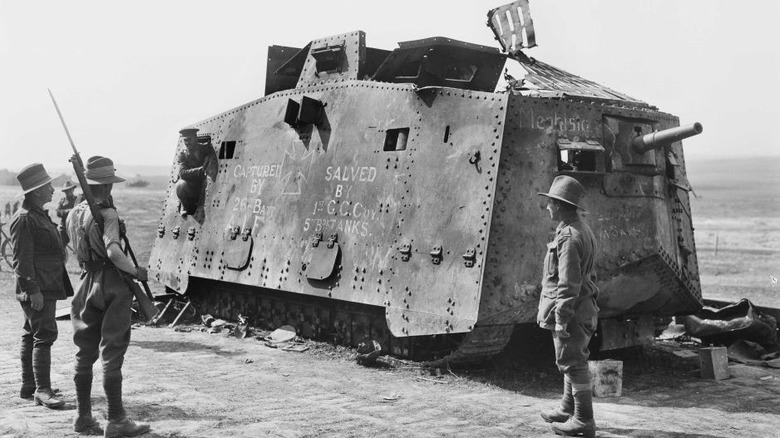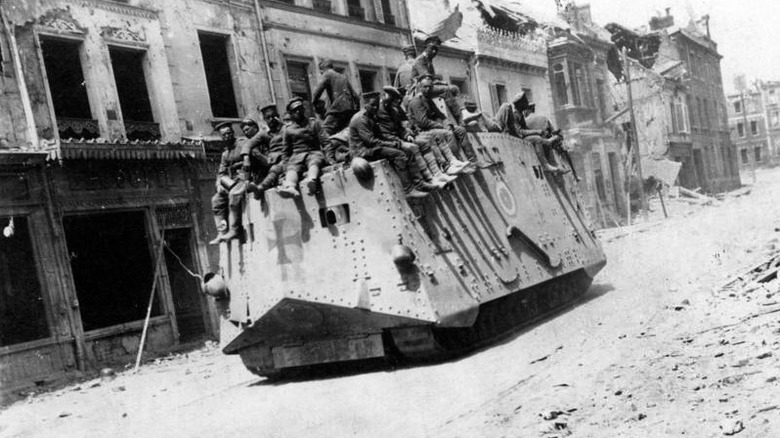The History Of Germany's WW1 A7V Sturmpanzerwagen - The World's Rarest Tank
The vehicles we know today as tanks emerged on a grand scale at the beginning of the 20th century, right before the First World War. In 1900, Britain commissioned steam-engine manufacturer John Fowler & Company to create a self-propelled vehicle to move supplies during the Second Boer War. Two years later, it was already engineering vehicles with mounted guns. Other world powers like France, Germany, Russia, and the United States followed suit, and the development of the modern tank was soon sparked by necessity with the outbreak of World War I.
Out of the ensuing arms race, Germany produced what some now refer to as "the rarest tank in the world." Named the A7V Sturmpanzerwagen, it was Germany's first official tank to be used in warfare. The design proved effective on the battlefield, achieving mostly mixed victories in combat. However, its formidable design was also its weakness, as German leaders were reluctant to dedicate resources to the logistical nightmare involved in its construction. As a result, only 20 A7Vs were ever constructed. Now, only a single A7V survives: the 506 'Mephisto' A7V model, the last of its kind.
The simple reason behind the A7V Sturmpanzerwagen's rarity is that Germany only managed to produce 20 operational models, all of which were only deployed in the final year of the war. It may seem a foolish oversight, but from the German leadership's perspective, observing the performance of British tanks in 1916, the vehicles seemed expensive and ineffective. Most of the first British tanks to see combat broke down before they even reached the battlefield. However, by 1918, when British tank units reached 2,600 units and French units reached around 3,000, Germany finally pulled the trigger and deployed its debut A7V tanks just as the war was reaching a close.
WWI German tanks were outnumbered 280 to 1
While German leaders were reluctant to develop a tank program, German commanders in the field had already read the writing on the wall. A greater number of French and British tanks were salvaged and reused by the Germans than the total number of German tanks produced. By the time the first A7Vs were sent into battle on March 21st, 1918, the offensive boost they provided wasn't enough to turn the tide of war.
In the following weeks, the newly deployed German tank force was whittled down by bad weather, barbed-wire entanglements, and minor Pyrrhic victories. The handful of A7Vs that pressed on during Germany's final 1918 Spring Offensive sent Allied soldiers fleeing. Unfortunately for the Germans, such gains were futile in gaining the upper hand as the final Allied counterattack, bolstered by American forces, pushed back.
The downfall of Germany's first armored division wasn't in its design but in its delayed introduction. Heavier and more sophisticated than the British Mark series tanks and the French Renault light tanks, the A7V Sturmpanzerwagen was well-suited for the Western Front. When WWI ended on November 11, 1918, the A7V was virtually retired the same year it was introduced.
The design specs of Germany's first and rarest tank
The A7V Sturmpanzerwagen is classified as a "heavy tank" thanks to its incredible weight and exceptionally reinforced armor. At around 65,900 pounds, it was heavier than the Mark I-IV heavy tanks used by the British, and much heavier than the surprisingly successful light French tanks. Yet, the extra bulk provided by its 30mm plate armor was subverted by the poor quality of its materials. The result was a lumbering, 26-foot-long beast that struggled to climb walls higher than 18 inches.
The A7V did have some notable advantages over its British and French counterparts, however. Its builder, Daimler Motor Company, employed two 100-hp Mercedes-Daimler engines. The dual-engine design was capable of reaching up to 8 mph while carrying an 18-man crew. That's relatively fast considering the A7V's weight; the French St. Chamond weighed 50,700 pounds and could reach 5.3 mph, while the British Mark I weighed 62,700 pounds and could reach 3.7 mph.
The A7V sported a 57mm Nordenfelt main gun with a 180-round reserve. It was supported by six 8mm water-cooled machine guns on all sides, which provided a 360-degree field of fire. Tellingly, the A7V's Nordenfelt guns were manufactured by the British and sold to Belgium in the late 19th century. When Germany took over Antwerp, they captured the guns and refitted them for its new tanks. The A7V might have been a hesitant start for Germany, but it laid the groundwork for the armored warfare to come.


